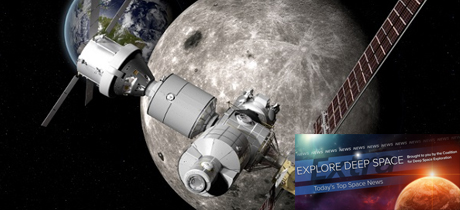In Today’s Deep Space Extra… Future human deep space exploration risks are best assessed in facilities not far from Earth, like the International Space Station and the planned lunar orbiting Deep Space Gateway.
Human Deep Space Exploration
Risky business: NASA experts discuss threats faced by space travelers
Seeker.com (5/16): Astronauts assigned to future deep space exploration missions are bound to encounter risks, according to experts assembled in Washington last week for the Explore Mars sponsored 2017 Human to Mars Summit. Assessing those risks, whether technical or health related, are best assessed close to Earth in venues like the International Space Station, according to experts.
Preparing for the Deep Space Gateway
The Engineer (5/15): NASA’s Flexible Deep Space Gateway, a lunar orbiting NASA space station, would be the link between the International Space Station and future missions to the Martian environs with human explorers. In addition to testing life support systems developed to support two to three yearlong missions to Mars, the gateway would expose astronauts to the physical and mental challenges of the long missions. NASA is focused on launching its first human mission to Mars in 2033.
GAO gives NASA mixed results for management of major projects
Spacepolicyonline.com (5/16): The U.S. General Accountability Office (GAO) warns in an audit of major NASA programs released Tuesday that the agency can expect major cost growth in two initiatives, the InSight Mars lander mission and upgrades to the Deep Space Network. However, the GAO notes management improvements in most of the agency portfolio. The GAO also noted that work on the Space Launch System and Orion crew capsule, cornerstones of NASA’s plans to resume human deep space exploration, are entering the most vulnerable stages of development. The report is the GAO’s ninth since the audit agency was mandated by Congress to make regular reviews as part of the 2009 appropriations process. In all, 21 NASA projects were examined.
Space Science
Mysterious light flashes 1st spotted by Carl Sagan explained
Space.com (5/16): NOAA’s DSCOVR satellite has a record of bright Earth flash observations from the Earth/Sun Lagrange 1 observing point. The source of the flashes appear to be reflections of light off high altitude ice crystals. The flashes were first brought to light by the U.S. astronomer Carl Sagan.
Low Earth Orbit
Alien planet-hunting camera successfully tested at International Space Station
Spaceflight Insider.com (5/17): The Charge Injection Device, a sensitive imaging device developed by the Florida Institute of Technology, has been successfully tested weeks after it was fastened to its perch outside the International Space Station, the Nanoracks External Platform. The CID is sensitive to faint as well as bright sources of light and could be instrumental in future studies of planets beyond the solar system. The device was launched to the Space Station in February.
Six Russian satellites to be launched in 2017
TASS of Russia (5/16): Russia is prepared for the launch of a half dozen domestic satellites this year. Their missions include communications, Earth observations, navigation and military.
A cubesat packed with cremated remains slotted for SpaceX ride share mission
Space News (5/16): San Francisco, California startup Elysium Space is entering the space burial business with plans to launch a secondary payload aboard a future SpaceX mission. An Elysium cubesat loaded with the cremated ashes from up to 300 customers will lift off from Vandenberg Air Force Base, California.
Launches from Georgia’s Camden spaceport could start In 2020
WJCT of Jacksonville, Fla. (5/17): Located north of Jacksonville, Camden County, Georgia, is planning an industrial park with a vertical spaceport. The effort requires an environmental impact statement, which is now in development and expected to take two years. The study will assess the impact of vertical rocket launches on the Cumberland Island National Seashore.

